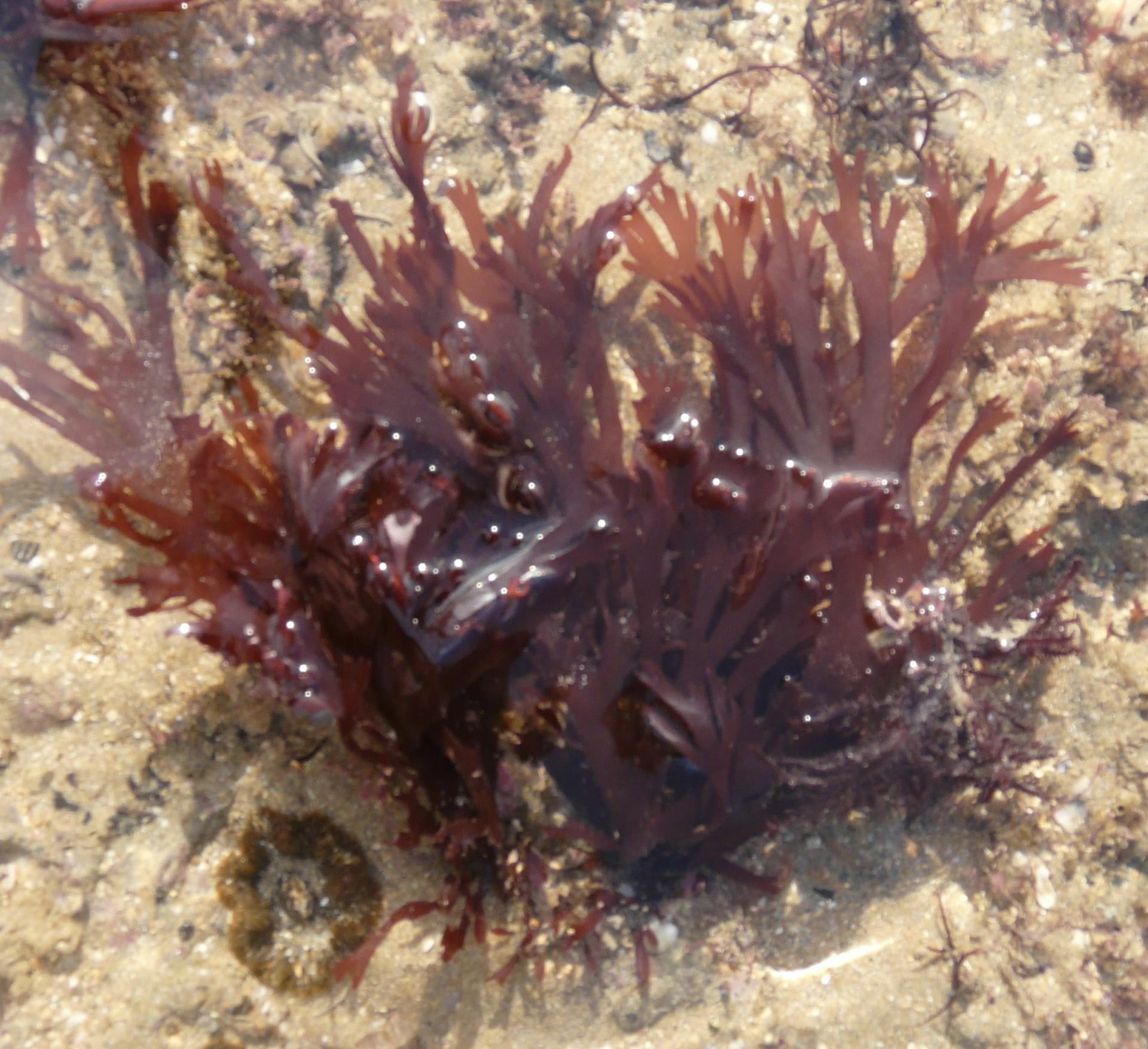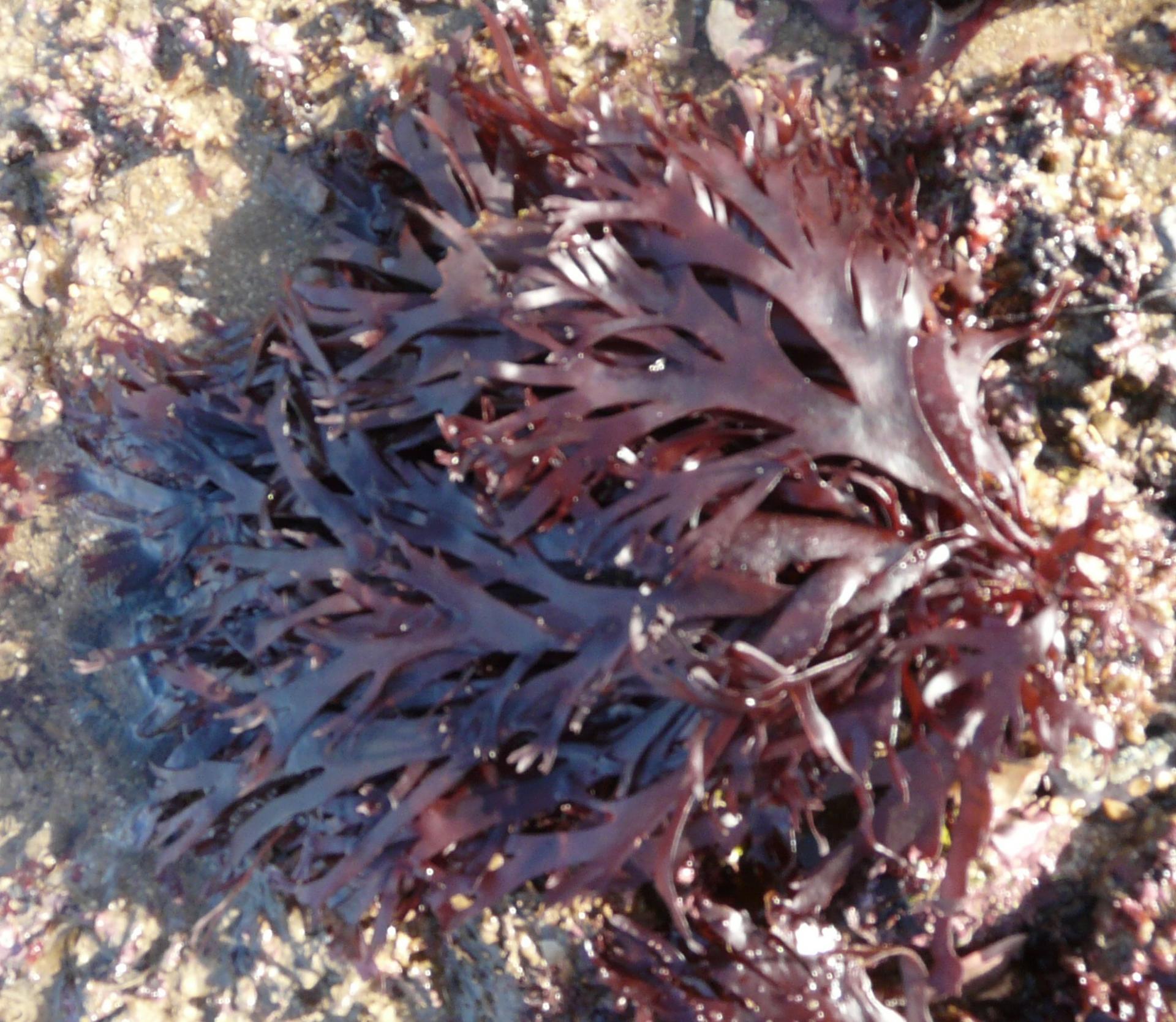Gracilaire en lanières
Gracilaria multipartita (Clemente) Harvey, 1846
Classification :
Plantae, Rhodophyta, Florideophyceae, Gracilariales, Gracilariaceae
Description :
Algue cartilagineuse et fragile, rouge brun, atteignant 30 cm de haut, profondément divisée en lanières épaisses de 2 à 10 mm de large. Le stipe comprimé, s'élargit progressivement jusqu'aux ramifications de la fronde. Celles-ci font entre elles des angles aigus et peuvent se diviser par deux ou trois jusqu'à six fois successivement . Les marges du thalles sont souvent prolifères (Cabioc'h et al., 1992 ; Hiscock, 1979).

Gracilaire en lanières (Gracilaria multipartita (Clemente) Harvey, 1846) dans une flaque ensablée à marée basse.

Gracilaire en lanières (Gracilaria multipartita (Clemente) Harvey, 1846) avec une fronde peu développée

Gracilaire en lanières (Gracilaria multipartita (Clemente) Harvey, 1846) avec de nombreuses ramifications dans la frange infralittorale
Écologie :
Algue pérennante de mode calme s'accrochant aux rochers et aux cailloux ensablés (Cabioc'h et al., 1992). Elle s'observe dans les flaques et les écoulements ensablés depuis la mi-marée jusqu'à l'infralittoral dans la zone intertidale des côtes de Charente-maritime. Elle peut aussi tolérer un certain envasement (Mayhew, 2002).
Distribution :
Elle ne dépasse pas au nord l'Irlande et le sud de la Grande-Bretagne. Elle s'observe jusqu'aux côtes du Sénégal et de l'Océan Indien en passant par la Méditerranée et la Mer Rouge. Elle a aussi été observée sur les côtes de la Nouvelle-Ecosse (Canada) et de l'Uruguay. Cette espèce d'algue est probablement largement distribuée dans les mers chaudes (Cabioc'h et al., 1992 ; Mayhew, 2002).
Intérêts :
Gracilaria multipartita est commercialisée comme source d'agar aux Etats-Unis (Mayhew, 2002).
Bibliographie :
Cabioc'h, J., Floc'h, J.-Y., Le Toquin, A., Boudouresque, C. F., Meinesz, A. & Verlaque, M., (1992) Guide des algues des mers d'Europe, Delachaux et Niestlé, Paris, pp.231.
Hiscock, S., (1979) A field Key to the British Brown Seaweeds, AIDGAP,vol. 5, Field Studies Council, Shrewsbury, ed. 1992, pp.44.
Mayhew, E.M. 2002. Gracilaria multipartita A red seaweed. In Tyler-Walters H. and Hiscock K. (eds) Marine Life Information Network: Biology and Sensitivity Key Information Reviews, [on-line]. Plymouth: Marine Biological Association of the United Kingdom. [cited 23-12-2017]. Available from: http://www.marlin.ac.uk/species/detail/1858
Gracilaria multipartita (Clemente) Harvey, 1846
Cleaved Wart Weed
Classification:
Plantae, Rhodophyta, Florideophyceae, Gracilariales, Gracilariaceae
Description:
Gracilaria multipartita is very brittle, cartilaginous, translucent, dull purple or reddish-brown algae which has fronds that measure up to 30 cm long. Short compressed stipe expanding into a blade to 1 mm or more thick. Branching narrow angled, up to 6 times di- or tri-chotomous (Hiscock, 1979). The margin of the blade is frequently proliferous (Mayhew, 2002).
Habitat:
Grows on rocks or other hard substrata, tolerating a wide degree of wave exposure. Recorded from the upper sublittoral to a depth of 15 m. Gracilaria multipartita is also tolerant of sand and mud cover (Mayhew, 2002).
Distribution:
Nord-est Atlantic from Ireland to Senegal shores, the Mediterranean, Nova Scotia Canada, Uruguay, the Red Sea and the Indian Ocean. Gracilaria multipartita is probably widely distributed in warmer waters (Cabioc'h et al., 1992 ; Mayhew, 2002).
Usage:
Gracilaria multipartita is commercially used as an agar or agaroid raw material in the U.S.A (Mayhew, 2002).
References:
Cabioc'h, J., Floc'h, J.-Y., Le Toquin, A., Boudouresque, C. F., Meinesz, A. & Verlaque, M., (1992) Guide des algues des mers d'Europe, Delachaux et Niestlé, Paris, pp.231.
Hiscock, S., (1979) A field Key to the British Brown Seaweeds, AIDGAP,vol. 5, Field Studies Council, Shrewsbury, ed. 1992, pp.44.
Mayhew, E.M. 2002. Gracilaria multipartita A red seaweed. In Tyler-Walters H. and Hiscock K. (eds) Marine Life Information Network: Biology and Sensitivity Key Information Reviews, [on-line]. Plymouth: Marine Biological Association of the United Kingdom. [cited 23-12-2017]. Available from: http://www.marlin.ac.uk/species/detail/1858
Ajouter un commentaire